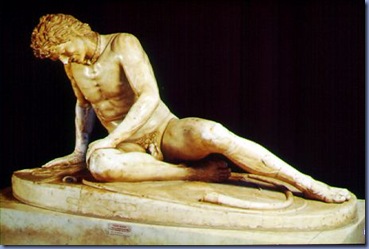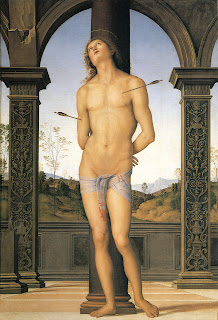The earliest representation of Sebastian is a mosaic in the Basilica of Sant'Apollinare Nuovo (Ravenna, Italy) dated between 527 and 565. The right lateral wall of the basilica contains large mosaics representing a procession of 26 martyrs, led by Saint Martin and including Sebastian. The martyrs are represented in Byzantine style, lacking any individuality, and have all identical expressions.
Another early representation is in a mosaic in the Church of San Pietro in Vincoli (Rome, Italy), probably made in the year 682. It shows a grown, bearded man in court dress but contains no trace of an arrow. The archers and arrows begin to appear by 1000, and ever since have been far more commonly shown than the actual moment of his death by clubbing, so that there is a popular misperception that this is how he died.
As protector of potential plague victims (a connection popularized by the Golden Legend) and soldiers, Sebastian naturally occupied a very important place in the popular medieval mind, and hence was among the most frequently depicted of all saints by Late Gothic and Renaissance artists, in the period after the Black Death. The opportunity to show a semi-nude male, often in a contorted pose, also made Sebastian a favourite subject. His shooting with arrows was the subject of the largest engraving by the Master of the Playing Cards in the 1430s, when there were few other current subjects with male nudes other than Christ. Sebastian appears in many other prints and paintings, although this was also due to his popularity with the faithful. Among many others, Botticelli, Perugino, Titian, Pollaiuolo, Giovanni Bellini, Guido Reni (who painted the subject seven times), Mantegna (three times), Hans Memling, Gerrit van Honthorst, Luca Signorelli, El Greco, Honoré Daumier, John Singer Sargent and Louise Bourgeois all painted Saint Sebastians.
The saint is ordinarily depicted as a handsome youth pierced by arrows. There were predella scenes, when required, often of his arrest, confrontation with the Emperor, and final beheading. The illustration in the infobox is the Saint Sebastian of Il Sodoma, at the Pitti Palace, Florence.
A mainly 17th-century subject, though found in predella scenes as early as the 15th century, was St Sebastian tended by St Irene, painted by Georges de La Tour, Trophime Bigot (four times), Jusepe de Ribera, Hendrick ter Brugghen and others. This may have been a deliberate attempt by the Church to get away from the single nude subject, which is already recorded in Vasari as sometimes arousing inappropriate thoughts among female churchgoers. The Baroque artists usually treated it as a nocturnal chiaroscuro scene, illuminated by a single candle, torch or lantern, in the style fashionable in the first half of the 17th century.
 There exist several cycles depicting the life of Saint Sebastian. Among them, the frescos in the "Basilica di San Sebastiano" of Acireale (Italy) with paintings by Pietro Paolo Vasta.
There exist several cycles depicting the life of Saint Sebastian. Among them, the frescos in the "Basilica di San Sebastiano" of Acireale (Italy) with paintings by Pietro Paolo Vasta.Egon Schiele, an Austrian Expressionist artist, painted a self-portrait as Saint Sebastian in 1915. During Salvador Dalí's "Lorca (Federico García Lorca) Period", he painted Sebastian several times, most notably in his "Neo-Cubist Academy". For reasons unknown, the left vein of Sebastian is always exposed.
In 1911, the Italian playwright Gabriele d'Annunzio in conjunction with Claude Debussy produced a mystery play on the subject. The American composer Gian Carlo Menotti composed a ballet score for a Ballets Russes production which was first given in 1944.
 In his novella Death in Venice, Thomas Mann hails the "Sebastian-Figure" as the supreme emblem of Apollonian beauty, that is, the artistry of differentiated forms, beauty as measured by discipline, proportion, and luminous distinctions. This allusion to Saint Sebastian's suffering, associated with the writerly professionalism of the novella's protagonist, Gustav Aschenbach, provides a model for the "heroism born of weakness", which characterizes poise amidst agonizing torment and plain acceptance of one's fate as, beyond mere patience and passivity, a stylized achievement and artistic triumph.
In his novella Death in Venice, Thomas Mann hails the "Sebastian-Figure" as the supreme emblem of Apollonian beauty, that is, the artistry of differentiated forms, beauty as measured by discipline, proportion, and luminous distinctions. This allusion to Saint Sebastian's suffering, associated with the writerly professionalism of the novella's protagonist, Gustav Aschenbach, provides a model for the "heroism born of weakness", which characterizes poise amidst agonizing torment and plain acceptance of one's fate as, beyond mere patience and passivity, a stylized achievement and artistic triumph. In 1976, the British director Derek Jarman made a film, Sebastiane, which caused controversy in its treatment of the martyr as a homosexual icon. However, as several critics have noted, this has been a subtext of the imagery since the Renaissance.
Renaissance artists had access to history that we currently do not. There was obviously some reason why they chose to depict him as a beautiful young man. Since Sebastian was a Gaul, it could have been influenced by the beauty of The Dying Gaul, one of my all time favorite statues. The warrior is depicted as a beautiful man, but there is obviously love and lust for his beauty that the sculptor saw. It is also likely that Renaissance artists may have known some historical gossip about Sebastian, or the loving relationships that existed between the early brothers and sisters in Christ. Who knows why they depicted him as a beautiful young man, but they have left behind a question for history and the beauty of man. Since many of the Renaissance artists were homosexuals, St. Sebastian allowed them to depict a beautiful naked (or nearly naked) young man, very similar to those young models they often used.






4 comments:
Very interesting series...I had never fully understoon the 'gay' connection with this catholic saint who appears often in the many churches in Europe, but at the same time is 'claimed' by the modern gay community. Now I have some insight!
Thanks!
From a gay Christian perspective, there are two elements to this that deserve some comment.
The first is that after the first, unsuccessful attempted execution by arrows, Sebastian did not simply "present himself" before the emperor. He returned specifically to harangue him for his wickedness - prompting the second and final execution. For modern gay men and lesbians, who find themselves persecuted by the church, the lesson is to follow the example of Sebastian - and to continuously challenge and confront the institutional Church, showing how its own wickedness and persecution of sexual minorities represents a clear departure from the example of Christ, whom they profess to follow. (See "Not Dead Yet: St Sebastian as Role Model", at Queer Saints and Martyrs).
The second point refers to your reference to the numerous homosexual artists of the Renaissance - many of whom received notable commissions from the popes and cardinals of the period. Some of these were frankly homoerotic in nature, pleasing the tastes of princes of the Church with a decided interest in male flesh. At the same time, the official position of the Catholic church was outright persecution of "sodomites", many of whom were burned at the stake for their activities.
When dealing with the hostility we receive from the church today, it is helpful to recall, and to publicize, the flagrant hypocrisy practised by these leaders of the Church in Renaissance times - and today.
I understand that the very early Christian images of Saint Sebastian show a rather grizzled old warrior. The beautiful near-naked boy is indeed a creation of the more sensual and morally corrupt Catholic Church of the Renaissance that also gave us Bernini's Saint Theresa whose "death agony" actually resembles orgasm more than anything else.
You're welcome, silvereagle.
Thank you so much for your informative and thoughtful comments, Terence.
Will, Bernini's Saint Theresa is quite a sight to see in real life. But where would we be without the beautiful art of the Renaissance?
Post a Comment